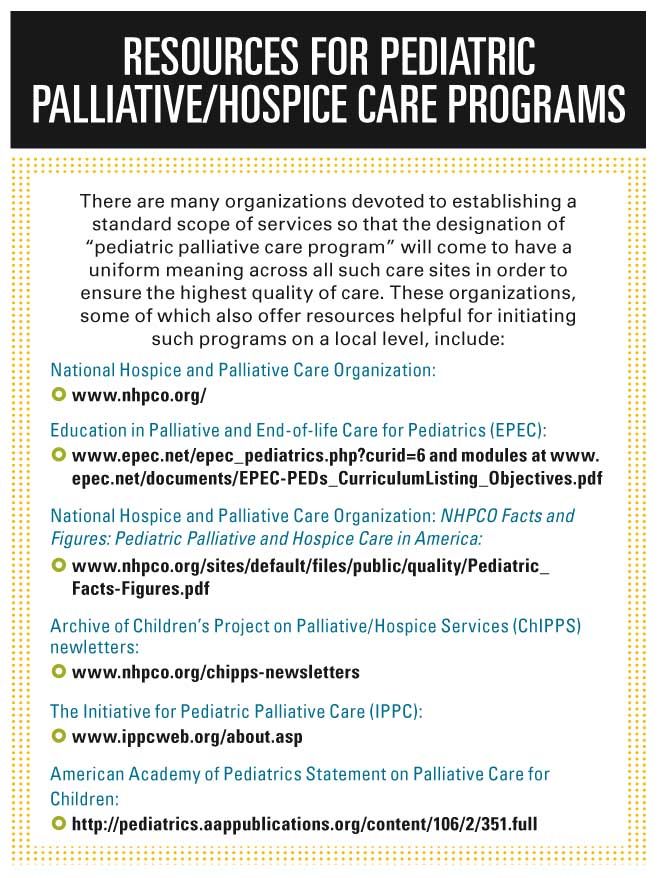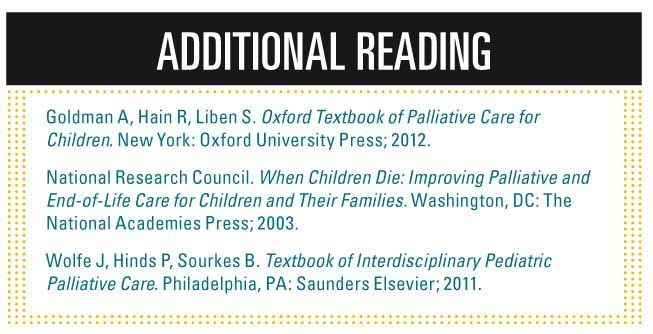Program gives children with life-limiting conditions quality of life
Providing quality-of-life care for the sickest of children was a passion for pediatrician Gary Ceneviva, MD. As a critical care physician, he was troubled by what he saw. So in true pediatrician fashion, he did something about it.
Editor’s note:
This new recurring feature will showcase novel hospital-based programs, innovations, and outreach initiatives that are meeting children’s health care needs in unique ways. Propose your story for The Hospital Zone via cradwan@advanstar.com

“The hummingbird is one of life's tiny miracles, just like our patients. A hummingbird's heart beats faster than any other bird. Its wings fly in the shape of a figure eight, the symbol of infinity. Hummingbirds are magical, mystical, and make our world a more beautiful place. In Native American traditions, the hummingbird has represented a messenger between worlds, helping to maintain the balance between nature and spirit. It is a creature that opens the heart and teaches others to appreciate the magic of being alive. The same lessons can be learned from the patients we are privileged to care for.”
-Penn State Hershey Children’s Hospital Hummingbird Program website
Providing quality-of-life care for the sickest of children was a passion for pediatrician Gary Ceneviva, MD. As a critical care physician, he was troubled by what he saw. “Unfortunately when children die, they typically die within an [intensive care unit (ICU)],” Ceneviva says. So in true pediatrician fashion, he did something about it.
Ceneviva started a program aimed at helping children with life-threatening conditions and their families to navigate the health care system, coordinate care, and support decision making, as well as meet their physical, spiritual, and psychosocial needs. Today, as medical director of the Hummingbird Program, Penn State Hershey Children’s Hospital, Hershey, Pennsylvania, Ceneviva and Deana Deeter, CRNP, CHPPN, CPON, Hummingbird Program manager, oversee a team of highly trained, committed professionals charged with ensuring that these kids and their families have not only the medical care they need, but also quality of life.
“We take care of children from birth to the end of life,” says Ceneviva, who is also boarded in hospice and palliative care.
Children in the program have a number of conditions, including chromosome anomalies, cancer, complex heart disease, severe pulmonary problems, genetic conditions, neurologic diseases, and more.
“[For example,] we see a number of patients with either genetic or neurologic issues. These patients often develop respiratory problems,” Ceneviva says. “Our program will assist in the medical and technologic management of these symptoms. During our discussions with the family, we converse on the pros and cons of various treatments and technologies and assist guiding the patient and family in complex decision making in accordance with their values, beliefs, and wishes.”
A growing need
As health care advances, so does the length of the lives of children with life-threatening illnesses. What’s often lacking, say doctors at the Hummingbird Program, is care that specifically takes their unique health circumstance into account.

Dr. Ceneviva“When I first started [developing] this back in the early 2000s, there were about half a million children estimated to have life-threatening conditions,” Ceneviva says. “The number now is approaching 1 million. Clearly these children have grown in complexity and grown in number.”1,2
In the past, these children only rarely received hospice or palliative care services.
“In 2001, the Children’s International Project on Palliative/Hospice Services (now the Children’s Project on Palliative/Hospice Services) estimated that 8,600 children would be eligible for palliative care services on any given day; however, only 5,000 of the 53,000 children who died that year received hospice services, and usually only for a brief period of time,” according to a 2009 document by the National Hospice and Palliative Care Organization (NHPCO).3
While it’s still true today that most children with complex chronic conditions die in the hospital setting, this is changing. Innovations in technology and changes in reimbursement are enabling an increasing number of medically fragile children to live their last days at home. Just over 10% of children aged 0 to 19 years died at home in 1989, versus about 18.2% in 2003.3
“Further breakdown of the data reveals that the odds of dying at home are reduced for black and Hispanic children. Geography also matters, as death at home is more likely in the West versus the northeastern United States,” according to NHPCO.3
Bumps on an already rocky road
Problems occur for these kids and their families especially during and after transitions of care, according to Ceneviva. Children might transition in a hospital among floor units, step-down units, and the ICU, or from hospital to home and back. Staff at the Hummingbird Program help children and families adjust.

Ms. Hahnlen“Having a strong care coordination component to this care is a lifeline for families,” says Nicole C. Hahnlen, RN, CHPPN, Hummingbird Program nurse coordinator. “Physicians often don’t have the opportunity to interact with patients and families quite as in-depth as I have the opportunity to. So, families have a real comfort level knowing they can pick up the phone and call and have a conversation with me, and I can certainly find a physician to address their needs.”
Christopher O’Hara, MD, who splits his time as a hospitalist at Penn State Hershey Children’s Hospital and as a pediatrician in the Hummingbird Program, says the program addresses potential care gaps. “Because of time constraints, some pediatricians are hesitant to care for these children. With a program like ours, whether it’s the family or the pediatrician, we can be contacted to sort of move things along,” O’Hara says.
Getting to goals
One of the key focuses of the Hummingbird Program is to help children and families identify, achieve, and reassess their goals.
“We did a study, looking at goals in 50 children with complex conditions,” Ceneviva says. “We found that, for most families, their desire was for their child to come home. Another desire was to have the child develop as fully as possible, whether emotionally, socially, or intellectually. Our role is often to assist in helping those families achieve those goals. If they’re in-house [and their goal is to go home], we would try to get them home and work with nursing agencies, hospices, durable medical equipment companies, and others, to get these children home and make sure they have adequate staffing to keep them home.”4

A pediatric partnership
While the Hummingbird Program and pediatric palliative care programs like it are uniquely positioned to provide a valuable bridge for patients’ families, its founders stress that in no way are they intended to take the place of community-based pediatricians and other non-hospital-affiliated programs.
“We’re not here to usurp any of the primary care from the pediatrician,” Ceneviva says. “We encourage the primary care physicians to maintain that valuable bond that they have with families.”
It’s imperative that a program such as this maintain an excellent relationship with all health care providers, whether they’re within the hospital or within the community, Ceneviva notes. “When [children are] making the transition from within the hospital to the community, one of our primary roles [often is] care coordination. That takes not only the work of our team but also the care providers within the hospital and, of course, the pediatrician,” he says.

Dr. OstrovThe frequency of services provided by the Hummingbird Program, which varies with each patient and family, is one practical factor in making pediatrician collaboration essential, adds Barbara Ostrov, MD, vice chair of pediatrics and pediatrician-in-chief, Penn State Hershey Children’s Hospital.
“Our program doesn’t always provide continuous care. Sometimes, there are consultations once or twice a year to help guide the primary care. Our program also provides consultations to help people understand what their wishes are for their child for end-of-life discussions. Some of those are more consultative because of the expertise,” Ostrov explains.
In-hospital and community-based pediatricians play a pivotal role in seeking out and referring patients and families for the programs. “We rely on pediatricians to make referrals to our program when they can or think they should,” says Ceneviva.
In his position as a hospitalist, O’Hara makes it a point to recognize children with complex life-limiting issues and let them and their families know about the program as a potential resource.
Like O’Hara, say the program founders, pediatricians in the community who might not be part of such a program themselves will hopefully familiarize themselves with the resource so that they, in turn, can share word of it when families in their care have occasion to confront end-of-life circumstances with their children.

REFERENCES
1. Himelstein BP, Hilden JM, Boldt AM, Weissman D. Pediatric palliative care. N Eng J Med. 2004;350(17):1752-1762.
2. Bramlett M., Read D, Bethell C, Blumberg SJ. Differentiating subgroups of children with special health care needs by health status and complexity of health care needs. Matern Child Health J. 2009;13(2):151-163.
3. Friebert S. NHPCO Facts and Figures: Pediatric Palliative and Hospice Care in America. Alexandria, VA: National Hospice and Palliative Care Organization; 2009.
.
4. Tamburro RF, Shaffer ML, Hahnlen NC, Felker P, Ceneviva GD. Care goals and decisions for children referred to a pediatric palliative care program. J Palliat Med. 2011;14(5):607-613.
Hospice care by the numbers
Gravely ill children, their families, and their pediatric providers in central Pennsylvania richly benefit from the presence of the Penn State Hershey Children’s Hospital Hummingbird Program in the community and its palliative care expertise garnered in the decade since its inception. How available are similar programs in your locale?
Programs focused on providing consulting services, coordination of care, and more for children with very complex medical needs exist around the United States, but they vary considerably from hospital-based programs to community agency or long-term care facility-based programs, according to the National Hospice and Palliative Care Organization (NHCPO).1 Designated pediatric palliative and/or hospice care units in hospitals also are rare, according to NHPCO, although Hummingbird Program pediatrician Gary Ceneviva, MD, believes there are 3 such programs at children’s hospitals throughout Pennsylvania alone.
In 2012, Feudtner et al conducted a national survey of 226 children’s hospitals and related institutions across the United States to ascertain the prevalence of pediatric palliative care programs, where they were located, what sorts of services they offered, their staff composition, and how they were funded (Figure).2
Of the 162 hospitals responding to the survey, 69% indicated they had initiated such programs with many variations in staffing, services levels, and funding sources. Hospitals with such programs included those in university (76.8%) and community (27.7%) settings and ranged in size from fewer than 101 beds to those with more than 250 beds. Eighty-eight percent of the responding hospitals provided consultation services but fewer than 12% had suites or beds dedicated to pediatric palliative care.
The survey found that of those hospitals responding, the oldest such program had been established in 1984, with the majority having been instituted within the past decade. As early as 2003, an Institute of Medicine report recognized that the end-of-life care issues and needs were markedly different in the adult and pediatric populations.3 With such recognition broadening across the medical community, by 2006 the American Board of Medical Specialties had recognized pediatric palliative care as a subspecialty and dedicated fellowship training programs had been formed.
The rapid growth of such programs in the intervening years is further evidence that pediatric palliative care has come to be considered an essential element in the care of children with life-limiting disease and their families.
Nationwide, program services vary widely, with some offering inpatient, outpatient, and bereavement care. Others are limited to educational services only and do not provide direct patient care. Of the 112 hospitals that had such a program established, 87 provided on-site daytime coverage on weekdays, and 5 did so on weekends. While some of the institutions filled the gaps with telephone coverage, one-third of the programs were unavailable either in person or via telephone on nights or weekends.
Like their service offerings, staffing, too, varies by program and institution. The Hershey Children’s Hummingbird Program staff, for example, is comprised of a program manager, who is a certified nurse practitioner in palliative care; a nurse coordinator; a pediatrician and a hospitalist, who also is board certified in pediatric hospice and palliative care medicine; and a pediatrician medical director. Other programs include chaplains and social workers.
Upon completion of their survey, Feudtner and colleagues concluded that pediatric palliative care programs were “a work in progress in terms of providing round-the-clock services and a full spectrum of services across the continuum of care,” and proposed that all such programs have 24-hour care as their goal, consistent with the Joint Commission’s Advanced Certification for Palliative Care standards.2
Starting a pediatric palliative/hospice care program
What if you are not fortunate enough to practice in the proximity of one of these programs? As Gary Ceneviva, MD, medical director of the Hummingbird Program, so inspiringly demonstrated, it is possible to muster community forces and build one from the ground up as he did. If so, consider these key clinical takeaways and recommendations for initiating a pediatric palliative/hospice care program:
- Data to make the case. Barbara Ostrov, MD, vice chair of pediatrics and pediatrician-in-chief, Penn State Hershey Children’s Hospital, says that often inpatient doctors, hospitalists, ICU doctors, or oncologists can help to identify and quantify complex care needs that are not being met by the routine inpatient focus or by the outpatient doctor. “It starts with that spark, really, where somebody says we need to do a more comprehensive, cohesive job for this population of kids,” Ostrov says.
- Conduct a needs assessment. Find out what the real needs in your community are, and determine the level of need for such services. One dedicated group of health care professionals in Dallas, Texas, banded together, assessed the regional need, and then successfully founded a pediatric palliative care program at Children’s Medical Center, Dallas. Their step-by-step primer can be read online.
- Align with a children’s hospital. Programs such as these cater to very complex pediatric needs, Ceneviva notes, and should, where possible and at some point in their development, be aligned with a children’s hospital. The programs can begin inside the hospital and branch out into the community, or they can be initiated in the community and eventually partner with a children’s hospital. Ensuring that the program reflects that hospital’s mission and core values can facilitate alignment and collaboration.
- Seek buy-in. These are by no means money-making programs, says Ostrov, but it’s not unusual for children’s hospitals to back such programs for which a pressing community need has been squarely established, she adds. Ceneviva says he and his staff marketed for the program by educating a wide variety of stakeholders, including hospital administrators, health care providers both in and out of the hospital, and civic leaders and community members.
Among other outreach tactics he employed, Ceneviva convened a series of roundtable forums to discuss what the program might look like and the goals he and his team hoped to achieve with its establishment. “We had insurers coming to the table. We had a number of hospices. We had nursing agencies come in, along with pediatric nurses and some physicians. It’s a collaborative effort,” he emphasizes.
- Collaborate with your resources. Extending beyond the core clinical team, learn what resources might be available in the community, including hospital chaplain departments that often hold end-of-life and bereavement expertise; college and university psychology departments; school district grief counseling resources; and hospices that might offer bereavement services and more, not only for the child but to serve the family as well. All the hospitals with pediatric palliative care programs that responded to the Feudtner survey had a relationship with hospice programs. Over 80% collaborated with 1 or more independent hospice organizations, and in 19% of the programs, the hospitals operated their own hospices.
- Pursue private funding. Finally, philanthropy is a requirement because reimbursement will not keep these programs afloat, Ostrov states. In fact, the Feudtner survey found that only 55% of such programs received operating funding from the hospital itself, although, interestingly, the level of hospital funding was not related to hospital size, the year the palliative care program had been established, nor the number of new consultations the program performed. Nearly 29% of such programs’ funding came from philanthropic sources.
“One of the things I’ve been very struck by in working in this particular field is that there are so many kind-hearted individuals that truly have a desire to collaborate,” Ceneviva reflects. “A lot of the turf wars that you see sometimes in other areas just seem to melt away when we start talking about palliative and end-of-life care for children.”
REFERENCES
1. Friebert S. NHPCO Facts and Figures: Pediatric Palliative and Hospice Care in America. Alexandria, VA: National Hospice and Palliative Care Organization; 2009.
.
2. Feudtner C, Womer J, Augustin R, et al. Pediatric palliative care programs in children's hospitals: a cross-sectional national survey. Pediatrics. 2013;132(6):1063-1070.
3. National Research Council. When Children Die: Improving Palliative and End-of-Life Care for Children and Their Families. Washington, DC: The National Academies Press; 2003.
MS HILTON is a medical writer in Boca Raton, Florida. She has nothing to disclose in regard to affiliations with or financial interests in any organization that may have an interest in any part of this article.




















